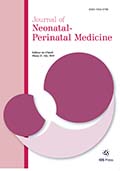Authors: Odd, David | Heep, Axel | Luyt, Karen | Draycott, Tim
Article Type:
Research Article
Abstract:
BACKGROUND: Mothers are increasingly given greater control over many of the choices around birth, although there is little robust evidence to inform these choices. After an infant is born with HIE the question of whether it was predictable, or preventable, is often raised. Intrapartum ‘sentinel’ events and antenatal predictors of HIE have been well described, however there is little evidence how antenatal and intrapartum factors interact. This is particularly important when elective delivery by lower segment caesarean section (LSCS) has been shown to be beneficial in high risk groups. AIM: To develop a clinical risk score to identify
…women with a higher risk of having an infant with HIE. PATIENTS AND METHODS: This study is based on the Avon Longitudinal Study of Parents and Children (ALSPAC). This dataset was split into two halves: with each infant being randomly allocated to either cohort one or two. The first cohort was used for the derivation of the model, while it was tested exclusively on the second. Logistic regression modelling was then performed to develop a predictive model. The final model was used to predict the outcome of infants in the second cohort and infants divided into four risk quartiles. To give some indication of possible avoidable disease, the proportion of infants with HIE, potentially avoided by earlier delivery, was estimated by assuming that medicalized delivery by elective LSCS at 37 weeks would remove intrapartum risk of HIE for those infants undelivered at this point. RESULTS: In the final model seven covariates remained (parity, preeclampsia, polyhydramnios, prelabor rupture of membranes, gender, concerns over fetal growth and prematurity). When applied to the second cohort, a ROC curve for the prediction of developing HIE in the newborn period showed good evidence for association (AUC 0.68 (0.60 to 0.77)) and the risk score derived was strongly associated with the risk of HIE, resuscitation and stillbirth, and neonatal death (all p < 0.05). Elective delivery of high risk infants at 37 weeks gestation could prevent 14% of all HIE, with a NNT of 41. CONCLUSION: It is possible to combine routine antenatal findings to identify infants at higher risk of neonatal HIE, thereby recognizing those infants who may benefit most from delivery by elective caesarean section. This work suggests a clinical risk score permits antenatal identification of high-risk infants whose outcome may be amenable to changes in clinical practice to potentially reduce HIE rates, and its devastating consequences.
Show more
Keywords: Birth, intrapartum, risk management, hypoxic ischemic encephalopathy, birth asphyxia, Apgar score
DOI: 10.3233/NPM-16152
Citation: Journal of Neonatal-Perinatal Medicine,
vol. 10, no. 4, pp. 347-353, 2017
Price: EUR 27.50





